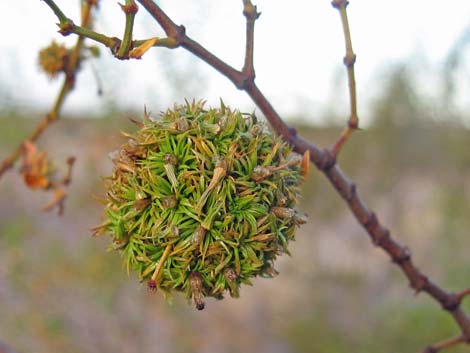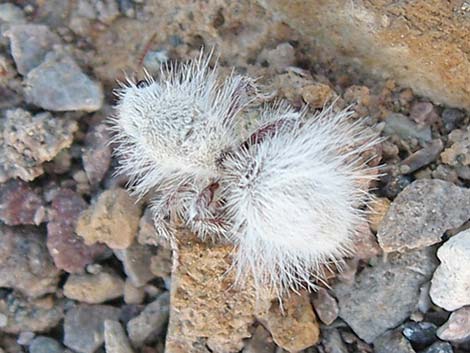
Shrubs Around Las Vegas, Vegetation Around Las Vegas
 Typical Creosote-Bursage Flats habitat where creosote bush (dark green) and white bursage (gray-white) dominate the landscape |
General: Creosote Bush (Larrea tridentata) is one of the signature plants of the southwestern deserts. Creosote Bush is an evergreen shrub with many branches emerging from the ground and radiating up and outward, typically to about 5-6 feet tall. The leaves are small (less than 0.5 inches), waxy, and resinous, with two leaflets joined at the base. The flowers are yellow with 5 petals, to about 1-inch across. Fruits are a small, white, fuzzy ball. Creosote Bush is the dominant species in the Lower Sonoran (Creosote-Bursage Flats) life zone, a major component of the Upper Sonoran (Mojave Desert Scrub) life zone, and fades out at the bottom of the Upper Sonoran (Pinyon-Juniper Woodland) life zone. Family: Caltrop (Zygophyllaceae). Other Names: Creosotebush, little stinker. Plant Form: Evergreen shrub with many crooked branches emerging from the ground and radiating up and outward. The plant can drop some or most of the leaves during drought. |
 Typical 5-6 foot tall shrub. Notice the many open, airy, crooked branches |
Height: Height depends on precipitation. Typical plants grow 5- to 6-feet tall. In dry areas such as the west side of the Sheep Range (rain shadow of the Spring Mountains), plants rarely exceed 3 feet. In well-watered areas such as along the edge of paved roads, plants can exceed 12 feet. Stems: Generally crooked and divided; young stems are banded. Leaves: Small (less than 0.5 inches), waxy, and resinous. Two leaflets are joined at the base. The leaf color depends on season (water): leaves are dark green to yellowish green during spring when water is available, but they turn brown during summer or when water is not available. Flowers: Petals 5, solitary, about 1-inch across, and yellow. The plant blooms when water is available, usually in the spring after winter rains and during summer after thunderstorms. |
 Creosote bush flowers and buds |
Seeds: Round, fuzzy, white capsule about 1/4-inches in diameter. Elevation: Up to about 4,500 ft. Comments: Creosote bushes are thought to include the oldest individual plants on earth. This species reproduces from seeds and by cloning, and some living clones in southern California have been carbon dated to having sprouted about 11,000 years ago, which is before the area was a dry desert. This species gives the desert a characteristic musky odor after summer rains. After summer thunderstorms (localized, heavy rain storms), patches or bands of bright green creosote bush stretching out across the landscape can be seen where it rained, while the surrounding landscape remains brown. Anna's Hummingbirds sometimes get nectar from the yellow flowers. |
 Fuzzy white seed capsules |
Creosote bushes produce growth-inhibiting (allelopathic) compounds in the leaves, and when the leaves fall to the ground, the chemicals can accumulate in the soil beneath these long-lived plants. In the dry Mojave Desert, the allelopathic compounds are very inhibiting to other shrubs (but not annuals). In the wetter Sonoran Desert, there is enough rain to wash away some of these growth inhibiting compounds. In this case, Creosote Bushes can become nurse plants and facilitate the germination and survival of other species. Text based on info from the Spadefoot Nursery in Tucson, Arizona. Creosote Bushes are crucial to the survival of many native bee species as a nectar plant, and many insect species are found only on Creosote Bushes. Species tied to Creosote Bushes include Creosote Katydids (Insara covillei), Creosote Bush Walking Sticks (Diapheromera covilleae), Creosote Grasshoppers (Bootettix argentatus), Lac Scale insects (Tachardiella larreae), Creosote Gall Midges (Asphondylia sp.), and the larval forms of many geometrid moths (family Geometridae) and bagworm moths (family Psychidae). Text based on info from the Spadefoot Nursery in Tucson, Arizona. |
 Creosote Leaves are forked (two leaflets are joined at the base) |
In an online discussion, the name, Larrea tridentata, was accused of being a bad name because it should be Larrea di-dentata, assuming that the name referred to the leaves, which are two-forked, not three forked. I had learned that tridentata referred to the bifid leaves that look like the twin side-spikes on the staff of Neptune's trident, making some sense of the two-forked leaves related to some three-forked thing. From an online resource, the etymology is: Larrea is named for Bishop Juan Antonio Hernandez Perez de Larrea (1731-1803) in Valladolid, Spain, while tridentata means three-toothed, the appearance of the leaves being three-toothed. As we can see (at left), this last part clearly is incorrect. I went online and looked up the original description of the plant, which was published in 1824 in France and written in Latin by Coville. The original name was Zygophyllum tridentatum. I speak neither French nor Latin, but assuming Google Translate is correct, the description includes: "subsessile bifoliolate leaves", recognizing the 2-forked leaves, and "petal and stamen scales tridentate at the apex." As such, the name refers to these 3-forked scales, not the leaves. So, once again, the scientific name does, in fact, make some sense, even if the scales generally are too small to see. |
 Typical upright, spreading stems from the base |
 Large and dense, but typical upright, spreading stems from the base |
 |
 |
 During extreme drought, plants die back, then sprout from the roots |
 During extreme drought, plants die back, then sprout from the roots |
 Leaves are forked (two leaflets are joined at the base) ... |
 ... but often are seen folded together |
 Flower buds |
 Flower buds |
 Flower buds |
 Flower buds |
 Flowers and flower buds |
 Flower and bud |
 Creosote Bush flower |
 Creosote Bush flower |
 Flowers and developing fruits |
 Spent flowers and developing fruits |
 Creosote Bush seeds on the ground |
 Creosote Bush seeds on the ground |
 Creosote Bush seeds on the ground |
 Creosote Bush seeds on the ground |
 Creosote Bush seeds on the ground |
 Rodents use the mound of sand that collects under the shrubs |
 Kangaroo Rat burrows in the sand mound under a shrub |
 Kangaroo Rat burrows in the sand mound under a shrub |
 Stem gall produced by a Creosote Gall Midge |
 White Velvet Ants hide in the desert by mimicking creosote seeds |
 Leaf-cutter bee working on a flower |
 Leaf-cutter bee working on a flower |
 Spider with legs folded in -- hiding by not looking like a spider? |
 Spider with legs folded in -- hiding by not looking like a spider? |
 Inchworm with banding pattern similar to young creosote bush stem |
 Inchworm with banding pattern similar to young creosote bush stem |
 Cocoon of Creosote Bush Bag Worm (Thyridopteryx meadii), a moth |
 Cocoon of Creosote Bush Bag Worm (Thyridopteryx meadii), a moth |
Note: All distances, elevations, and other facts are approximate. Names generally follow the USDA database.
![]() ; Last updated 240628
; Last updated 240628
| All Shrubs | Plant Species Index | Glossary | Copyright, Conditions, Disclaimer | Home |